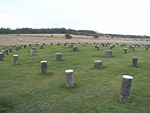Church of St Mary and St Melor, Amesbury
12th-century church buildings in EnglandAmesburyChurch of England church buildings in WiltshireGrade I listed churches in WiltshireOpenDomesday ... and 2 more
Use British English from October 2020William Butterfield buildings

The Church of St Mary and St Melor is the parish church of the town of Amesbury, Wiltshire. The Grade I listed church dates from the 12th century and may be connected with the 10th-century Amesbury Priory or its 12th-century successor, Amesbury Abbey.
Excerpt from the Wikipedia article Church of St Mary and St Melor, Amesbury (License: CC BY-SA 3.0, Authors, Images).Church of St Mary and St Melor, Amesbury
Church Street,
Geographical coordinates (GPS) Address External links Nearby Places Show on map
Geographical coordinates (GPS)
| Latitude | Longitude |
|---|---|
| N 51.1719 ° | E -1.7843 ° |
Address
St Mary & St Melor
Church Street
SP4 7ES , Amesbury
England, United Kingdom
Open on Google Maps








